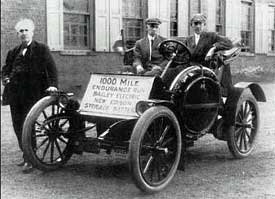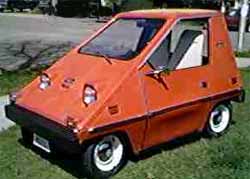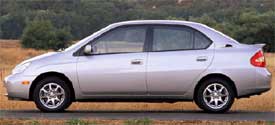Electric and Hybrid Vehicles
Although electric vehicles seem futuristic, they have actually been around for more than 150 years! The first electric vehicles were small electric rail cars, which were demonstrated in the 1830s. Unfortunately, they required better batteries than those that existed at the time. It was not until the 1860s that inventors devised batteries that could be recharged numerous times. This was a necessity for an electric vehicle to be commercially practical. However, even with the new batteries, small electric rail cars could not compete with the giant steam-powered locomotives of the day.
By the 1880s, larger secondary batteries became available and there was a renewed interest in electric vehicles. Large railroad locomotives were still impractical, but small, electric road-going vehicles seemed possible. In the 1890s electric cars were beginning to catch on with the general public. In 1899 a Belgian electric car set a new land speed record—68 miles per hour. At about the same time, electric buses and taxis began operating in London and New York. Electric cars were also much more reliable than gas or steam models and didn’t need to be cranked to start, as did cars with gasoline engines. Even Thomas Edison was convinced that electric cars were better, and for a number of years he tried to invent a better battery for them.
Things began to change in the early years of the 20th century. People took to motoring with a passion and began wanting to travel greater distances in their cars. Because they needed to be recharged, electric cars had a limited range of only 20 miles or so. Gasoline and steam cars could go much farther. In the early days of driving, when roads were poor and cross-country trips were uncommon, that difference hadn’t mattered so much. The change in driving patterns and the success of low-cost gas-powered cars like the Ford Model T drove electric competitors out of the market, and the gasoline engine became the standard for most of the 20th century.
Interest in electric cars never completely vanished, however, and in the early 1970s, with gas prices soaring and concerns about the environment growing, the idea of an electric car returned. Many proposals for electric cars emerged both from independent inventors and from the established auto manufacturers. These early models met with limited success. One small electric “commuter” car called the Citicar, sold over 2,000 units in the United States. The U.S. Postal Service also purchased 350 delivery Jeeps with electric motors from the AMC Corporation. These trucks had a top speed of 50 miles per hour and a range of about 40 miles before they needed to be recharged. Even so, it was clear that although gasoline and electric motors had been continuously improved during the previous seventy years, the old problem with batteries remained.
Since the 1970s, engineers have been working to improve batteries, but even the best electric cars are still only able to travel a fraction of the distance of the average gasoline automobile. Governmental incentives to use alternative fuel automobiles have continued to stimulate experimentation, especially since the early 1990s. Since batteries stubbornly refused to improve, however, engineers have changed tactics.
One solution is the hybrid vehicle, which uses both an electric motor and a gasoline motor. The first hybrid was patented in 1905, but little became of it until almost a century later. In the mid-1990s Toyota introduced the first commercial hybrid electric vehicle (HEV), the Prius. This vehicle, and another offered by Honda, uses a small gasoline motor supplemented by an electric motor. The combination gives good acceleration and gas mileage of up to about 50 miles per gallon. There are other HEV designs where the gasoline motor drives a generator, which in turn supplies electricity to an electric motor that propels the car. Because HEVs provide good drivability, high mileage, and low emissions using technology that is available today, their chance of success seems good. Although they are much different than the original battery powered electric cars, they still represent a triumph for those who have long promoted the use of electric motors in automobiles.


